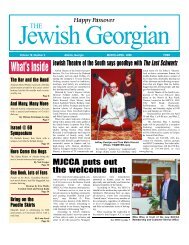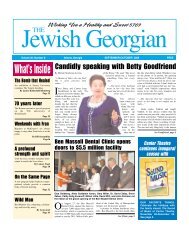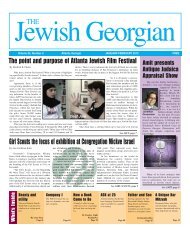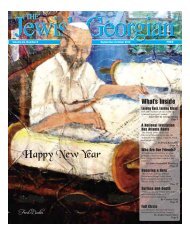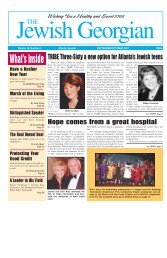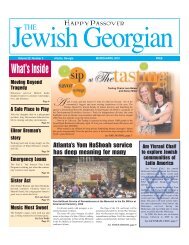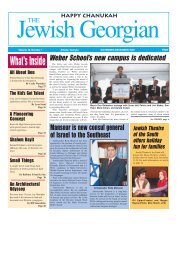FEDERATION NEWS - The Jewish Georgian
FEDERATION NEWS - The Jewish Georgian
FEDERATION NEWS - The Jewish Georgian
You also want an ePaper? Increase the reach of your titles
YUMPU automatically turns print PDFs into web optimized ePapers that Google loves.
July-August 2012 THE JEWISH GEORGIAN Page 7<br />
Savannah’s JEA is wrapping up its centennial celebration<br />
By Jane Guthman Kahn<br />
Savannah’s <strong>Jewish</strong> Educational<br />
Alliance is celebrating its 100th anniversary.<br />
Centennial year activities will conclude<br />
Sunday, September 9, with “Bites +<br />
Bubbly,” a gala evening of food, festivities,<br />
and fundraising. <strong>The</strong> event is designed to<br />
“reflect on the 100 years of JEA service,<br />
while celebrating the future of 100 more to<br />
come.”<br />
<strong>The</strong> JEA, which through the years has<br />
resisted a name change to “<strong>Jewish</strong><br />
Community Center,” is, in fact, Savannah’s<br />
<strong>Jewish</strong> community center. For years, it has<br />
also been known by its nickname, the<br />
Alliance. It was chartered in 1912, with the<br />
idea of creating one institution to meet the<br />
needs of Jews of all ages. <strong>The</strong> Council of<br />
<strong>Jewish</strong> Women had proposed a home for a<br />
permanent kindergarten, just one of several<br />
identified needs.<br />
In the early 1900s, this coastal Georgia<br />
town, one of the oldest <strong>Jewish</strong> communities<br />
in the United States, experienced an influx<br />
of <strong>Jewish</strong> immigrants from Europe, who<br />
needed help adjusting to life in America.<br />
That became JEA’s focus—to create an<br />
environment in which the middle-class<br />
German Jews, who arrived earlier, could<br />
help assimilate the new (and poor) Eastern<br />
European Jews, who were streaming into<br />
the city. <strong>The</strong> JEA would provide them with<br />
baths (today, some old-timers remember<br />
going to the old JEA for showers) and teach<br />
them language, sports, and manners.<br />
<strong>The</strong> goal was to produce Americans<br />
who would not embarrass the established<br />
<strong>Jewish</strong> residents and would be able to blend<br />
into the general community.<br />
<strong>The</strong> idea had been brewing for a while.<br />
Dr. George Solomon, long-time and<br />
beloved rabbi of Savannah’s Congregation<br />
Mickve Israel, had advocated for years for a<br />
<strong>Jewish</strong> center as a spiritual force for the<br />
unification of the community. Some talked<br />
of an institution to educate immigrants; others<br />
felt the need for a common meeting<br />
place.<br />
Sigo Meyers offered a gift of $25,000<br />
to create a memorial to his brother, former<br />
Savannah Mayor Herman Myers. <strong>The</strong> gift<br />
was to be matched by the <strong>Jewish</strong> community.<br />
In 1914, two years after its organization,<br />
the JEA began operations, in a leased threestory<br />
house in downtown Savannah. <strong>The</strong><br />
year before, it chartered Boy Scout Troop 2.<br />
In January 1916, the organization<br />
moved into a handsome new three-story<br />
structure on Barnard Street, in downtown<br />
Savannah. (That building, which took a<br />
mere six months to build, is now a dormitory<br />
for the Savannah College of Art and<br />
Design.) With the opening of the new JEA<br />
home, Dr. Solomon proclaimed, “<strong>The</strong> community<br />
had builded [sic] far better and<br />
wiser than it knew.” (Rabbi Solomon was to<br />
serve Congregation Mickve Israel and the<br />
Savannah community for 42 years.)<br />
But, with the onset of World War I and<br />
many members joining the armed forces,<br />
the JEA fell into debt and was forced to<br />
close, leasing the building as a school. A<br />
skeleton group kept it alive. <strong>The</strong> Hebrah<br />
Gemiluth Hessed (HGH), a benevolent<br />
society chartered in 1889, donated “a substantial<br />
sum” to initiate a fundraising campaign,<br />
and in 1920, the JEA reopened.<br />
In a 1930 celebration, Sigo Myers said,<br />
“...the institution has more than realized the<br />
hopes I entertained at its founding. To the<br />
young people...it has become a home and<br />
JEA BOY SCOUT TROOP NO. 2, MARCH 15, 1914. Front row (from left):<br />
Abraham “Chief” Harris (nee Horovitz), Joseph Apolinski, Selig Richman,<br />
LeRoy Fischer, Louis “Bum” Lasky (drummer), Emanuel Kronstadt,<br />
Benjamin Chernoff, Leon “Lukie” Tenner, and Joseph Greenberg. Center<br />
row: Perry Stone, Morris Rubin, Joseph Weiss, Benjamin Litman (bugler),<br />
Joseph Litman (scoutmaster), Ruben Siegel, Jacob Stone, Jacob or Ruben<br />
Greenberg, and Rubin Tenenbaum. Back row (holding flags): Nathan<br />
Marcus, Morris Mohre, Louis Bradley, and Isidore Apolinski. (Donated to the<br />
Savannah <strong>Jewish</strong> Archives by Albert Ullman)<br />
an inspiration. To the older men...a rallying<br />
place...our non-<strong>Jewish</strong> neighbors have<br />
come to look upon...the representative<br />
<strong>Jewish</strong> organization of Savannah.”<br />
During the 1920s, <strong>Jewish</strong> life revolved<br />
around the JEA, and many clubs and organizations<br />
that started then remain today.<br />
During the Great Depression, involvement<br />
increased, and, in 1939, the board voted to<br />
sell the Barnard Street building and expand<br />
elsewhere. But World War II intervened,<br />
and the building plans were put on hold.<br />
<strong>The</strong> JEA became a USO center, welcoming<br />
members of the armed forces from around<br />
the area. In 1946, the JEA opened the first<br />
<strong>Jewish</strong> day camp in Savannah.<br />
In 1950, the JEA site committee identified<br />
an 11 1/2 acre tract, eight blocks south<br />
of what were then Savannah’s city limits,<br />
for its new location. Funds raised from<br />
1943 through 1954 were less than a half<br />
million dollars, but the institution moved, in<br />
September 1955, to the building it now<br />
occupies. JEA Executive Director Adam<br />
Solender commented recently on the<br />
“incredible commitment JEA leaders made<br />
to the community and each other,” in undertaking<br />
the construction of a new facility in<br />
the mid-20th century.<br />
During the 1990s, the building underwent<br />
major renovations, and an addition<br />
was built. Today, the 80,000-square-foot<br />
complex houses a fitness center, gyms, racquetball<br />
courts, an outdoor swimming pool,<br />
an indoor lap pool, and athletic fields. As in<br />
the early days, pick-up basketball is a<br />
lunchtime activity, but the health and wellness<br />
program today also includes adult<br />
recreation, youth sports, water aerobics,<br />
yoga, personal training, and fitness classes.<br />
<strong>The</strong> summer camps continue to be popular,<br />
as well as seasonal holiday camps. Weekly<br />
senior lunches, with programming, are well<br />
attended—the JEA provides transportation<br />
as needed.<br />
<strong>The</strong> JEA continues to offer concerts<br />
and speakers on a variety of subjects and<br />
also sponsors weekly games (Scrabble,<br />
bridge, Mah Jongg) an annual film festival,<br />
and monthly exhibitions featuring local<br />
artists. As it always has, the JEA adapts its<br />
programming to the needs of the community.<br />
An agency of the United Way (which<br />
See SAVANNAH’S JEA, page 13<br />
JEA BASKETBALL,<br />
1921-22. Front row<br />
(from left): Louis<br />
“Libe” Gittelsohn,<br />
Isadore “Izzy”<br />
Itzkovitz, Fred<br />
Rosolio (captain),<br />
Mortimer “Bud”<br />
Fischer, and Harry<br />
Marcus (also known<br />
as Dick Leonard).<br />
Back row: Frank<br />
Buchsbaum (cheerleader),<br />
Louis “Bum”<br />
Lasky, Emanuel<br />
Kandel, Jacob “Jack”<br />
Saul (nee<br />
Savilowsky), and<br />
Jerome Eisenberg.<br />
JEA SUMMER CAMP, AUGUST 1947. Identified: Barbara (Mirsky) Seligman,<br />
Murray Freedman, Isser Gottlieb, Lillian (Heyman) Lowe, Arnold Tillinger,<br />
Brenda (Hirsch) Schimmel, Gilbert Kulick, Lynn (Schlosser) Levine, Beth<br />
(Odess) Fagin Childress, Sammy Feinberg, and Frances (Solomon)<br />
Gretenstein.



